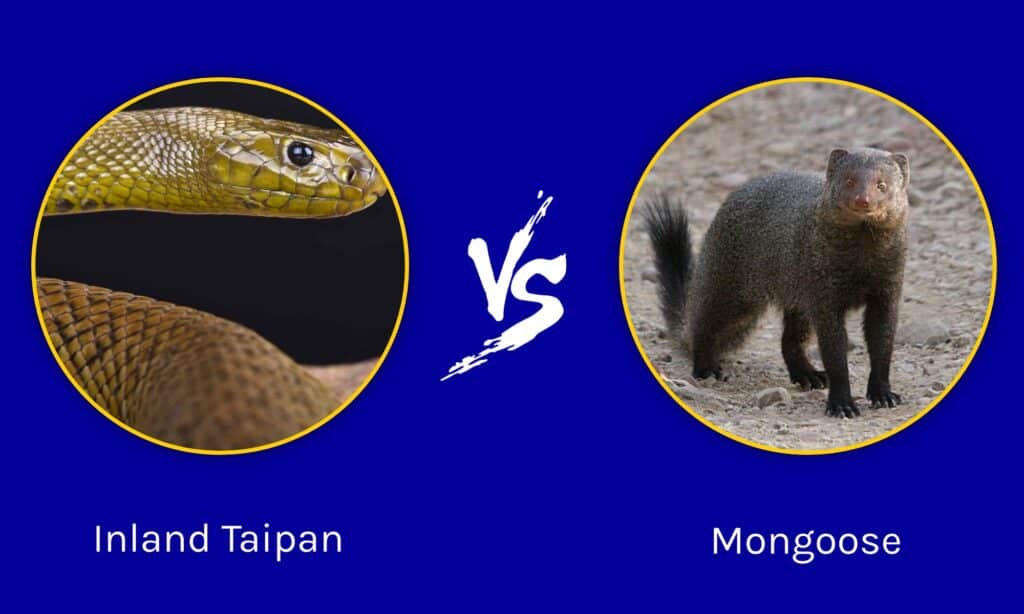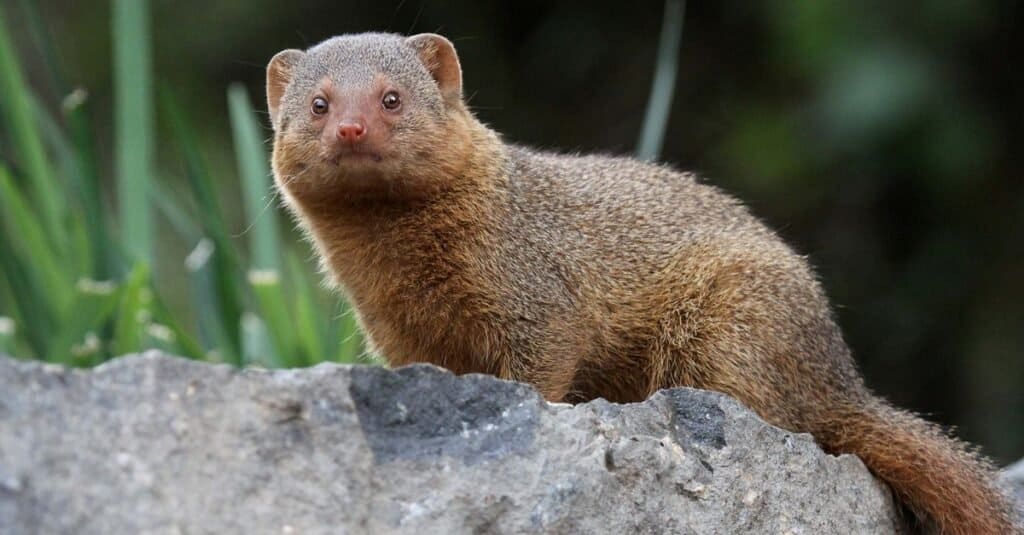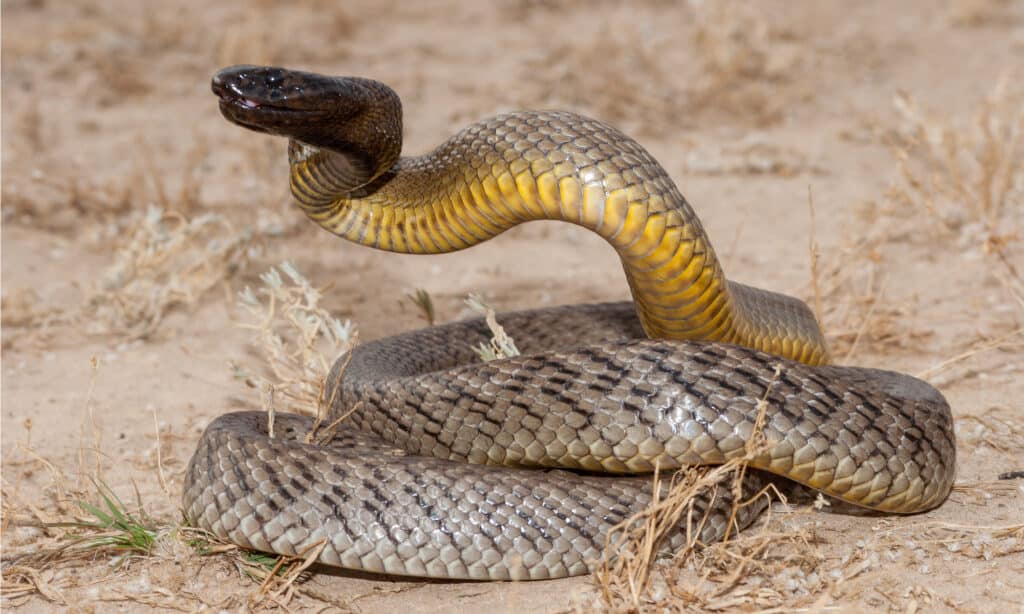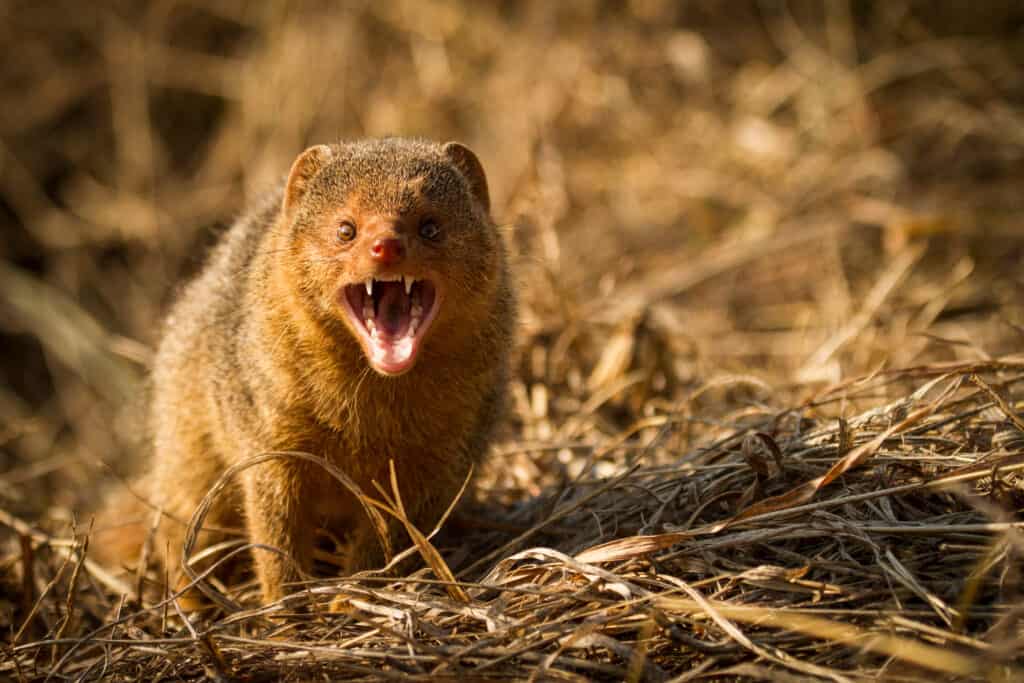The inland taipan goes by many names. Whether the reptile is called the fierce snake, western taipan, or the small-scaled snake, it’s deadly all the same. In fact, this snake regularly ranks among the top 10 most venomous snakes in the world, and it may just possess the most powerful venom of any snake. Nevertheless, we have to wonder what would happen in an inland taipan vs mongoose fight.
After all, the mongoose is known to specifically hunt down and eat venomous snakes. This terrestrial mammal actually has an omnivorous diet, including some plants in addition to rodents, worms, birds, insects, and small reptiles. But it is renowned for its aggression when threatened.
Let’s take a closer look at how this fight would go and which animal would win.
Comparing an Inland Taipan and a Mongoose

| Inland Taipan | Mongoose | |
|---|---|---|
| Size | Weight: 3lbs-4.4lbs Length: 4ft-6ft, up to 9ft maximum | Weight: 0.7lbs – 11lbs Length: 0.8ft-2.5ft |
| Speed and Movement Type | 5 mph (estimated, not observed) | – Up to 20 mph – Runs with a gliding gait, head low to the ground. |
| Attacking Method | – Considered the deadliest venom in the world – 44mg average venom load with 110mg maximum – Capable of killing between 100 and 280 humans with a single bite – Nearly 100% envenomation rate and delivers several bites – Accurate, fast, and numerous fast bites | -28 teeth – 4 powerful incisors capable of breaking bones – Powerful sense of smell used to find burrowed prey – Good sight during the day – Very good hearing used for hunting. |
| Defenses | – Prefers to run away from confrontations | – Thick fur that deters bites and holds – Limited resistance to snake venom |
| Predatory Behavior | – Ambush predator | – Some species hunt alone, others together – Pursuit hunters |
What Are the Key Differences Between an Inland Taipan and a Mongoose?

Mongooses are noted for their audacious attacks on highly venomous snakes, such as king cobras.
©steve bushman/Shutterstock.com
The greatest differences between an inland taipan and a mongoose include their morphology, size, and approach to fighting. An inland taipan is a reptile that slithers along the ground, envenomates creatures to kill them, and weighs about 4 lbs. But the mongoose is a carnivorous mammal that bites creatures to death and weighs up to 11 lbs.
These differences are not only useful in telling the animals apart, but they can also provide us with a baseline to explore the key factors between the creatures and figure out which one has an advantage in a fight.
What Are the Key Factors in a Fight Between an Inland Taipan and a Mongoose?

The inland taipan and mongoose fight would be settled by speed, power, and size.
©Ken Griffiths/Shutterstock.com
The biggest factors that we need to examine in the battle between an inland taipan and a mongoose are rather typical of battles in the animal world. We must consider size, speed, and attacking methods along with other features of the animals. By sizing them up and assigning relevant advantages, we’ll have a good idea of the bout’s winner.
Inland Taipan vs Mongoose: Size
A mongoose is larger than an inland taipan. On average, a mongoose will weigh up to 11 lbs and measure 2.5ft long. However, an inland taipan will weigh about 4.4 lbs and measure about 4 ft-6 ft in length.
The Mongoose has an overall size advantage even though it lacks length.

Mongooses are fast and have been clocked running at 20 mph.
©Mark Sheridan-Johnson/Shutterstock.com
Inland Taipan vs Mongoose: Speed and Movement
A mongoose is much faster than an inland taipan. The snake moves at about 5 mph or less. These snakes are rarely observed slithering very far in the wild due to their reclusive nature. However, the mongoose has been witnessed running at speeds up to about 20 mph.
The Mongoose has a very distinct speed advantage.
Inland Taipan vs Mongoose: Attacking Methods
An inland taipan has very deadly attacking methods. They have a bite that is capable of killing up to 280 humans with their uniquely powerful venom. These snakes can deliver that amount with a single bite, but they rarely bite once.
These snakes bite quickly, accurately, many times in a row, and always envenomate their foes. When the fierce snake strikes repeatedly, it often bites the same spot over and over. Then, once their venom sets in, it induces pain, nausea, vomiting, abdominal pain, diarrhea, dizziness, convulsions, and headache. After that, the venom attacks vital organs, precipitating kidney failure, neurotoxicity, coagulopathy, and death.
The Mongoose has evolved to hunt snakes. They have 28 teeth that can shear flesh, puncture snake skulls, and break bones. Moreover, they have great senses including smell, sight, and hearing. They’ll easily root out animals from their burrows and kill them.
Both animals are incredibly effective at attacking others, but the inland taipan is far deadlier in general.

The Inland Taipan is the most venomous snake on earth with the ability to kill 100 people with one bite.
©Alizada Studios/Shutterstock.com
Inland Taipan vs Mongoose: Physical Defenses
The Mongoose has thick fur that deters bites and makes it hard to hold the animal. Moreover, they have a resistance to some forms of snake venom and enough agility to escape predators.
Inland taipans tend to run away from fights before they begin. However, they will fiercely defend themselves if cornered.
The inland taipan has better defenses than a mongoose.
Inland Taipan vs Mongoose: Predatory Behavior
The inland taipan is an ambush predator that waits for its prey to come by and then strikes. They can lash out and bite very quickly, and their venom usually takes hold of the prey in minutes.
Mongooses are interesting because they can hunt in groups with other members of their species, or they can hunt alone. They utilize persistence hunting in some cases, like venomous snakes, but they also actively seek out prey while going through their day-to-day lives.
The ambush of an inland taipan is effective, but the mongoose would most likely sense the snake before it was able to strike get a free strike.
Who Would Win in a Fight Between an Inland Taipan and a Mongoose?

A mongoose is a tough customer for any venomous snake.
©Millie Bond – Copyright A-Z Animals
A mongoose would win a fight against an inland taipan, but the mongoose might die shortly after winning. Mongooses have limited resistance to some snake venom. However, these mammals live in Africa; they are not accustomed to the venom of the inland taipan from Australia.
The fight would start as soon as the mongoose notices the snake. Most of the time, mongooses use their speed and agility to move around and test the limits of their prey. The inland taipan has never fought anything like a mongoose, so it might overextend itself and leave itself open to a bite.
The Mongoose will inevitably find a way to take a bite out of the inland taipan. The size differential and the power that this mammal can generate will end the fight quickly. However, getting that close to such a quick snake could result in envenomation.
There are two potential outcomes. The Mongoose will bite the inland taipan to death without getting bitten. Otherwise, the mongoose will get bitten in the process of killing the snake, getting a short-lived victory.
The chances of the inland taipan surviving a tussle with a mongoose, even with its powerful venom, seem somewhat low.
The photo featured at the top of this post is © reptiles4all/Shutterstock.com
Thank you for reading! Have some feedback for us? Contact the AZ Animals editorial team.






